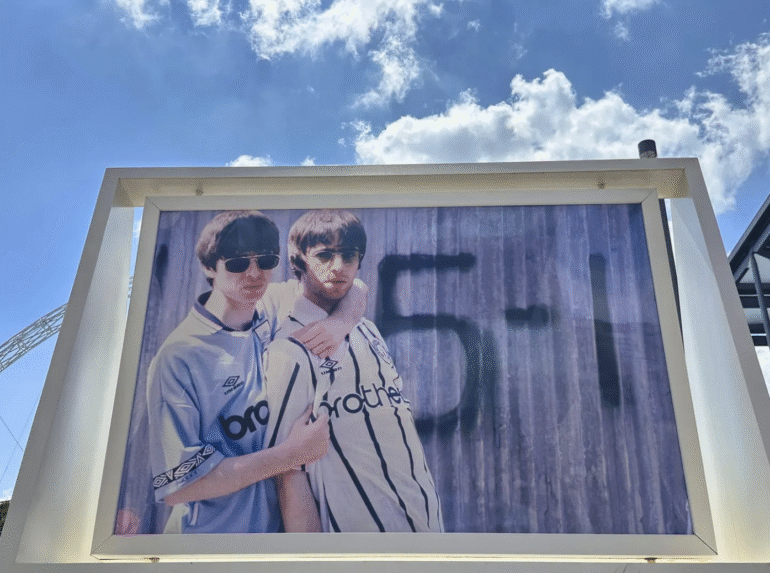As Oasis-mania grips the UK during the Oasis Live ’25 Tour, Culturalee spoke to legendary music photographer Kevin Cummins and curator Claudio Giambrone (Head of Cultural Programming at Wembley Park) to discuss their striking new collaboration: Brothers: Liam and Noel Through the Lens of Kevin Cummins, an outdoor exhibition at Wembley Park that captures a pivotal moment in British music history.
The exhibition features over 20 large-format photographs showcasing a series of intimate portraits Cummins took of Liam and Noel Gallagher in 1994–just before Oasis released their era-defining debut album Definitely Maybe and rocketed to global fame. With Cummins’ signature eye for mood and myth, and Claudio’s curatorial vision, Brothers offers a raw, resonant glimpse into the early chemistry and complexity of the Gallaghers as they stood on the brink of going Supersonic.
Claudio Giambone curated the Brothers exhibition from the personal archive of Kevin Cummins–which contains more than 150 photographs–and from his bestselling book Oasis: The Masterplan. Brothers includes images from Oasis’s first-ever studio session at Sly Street Studio in February 1994, candid hotel-room photos from their early UK tour and a portrait of the band taken in Manchester’s Back George Street.
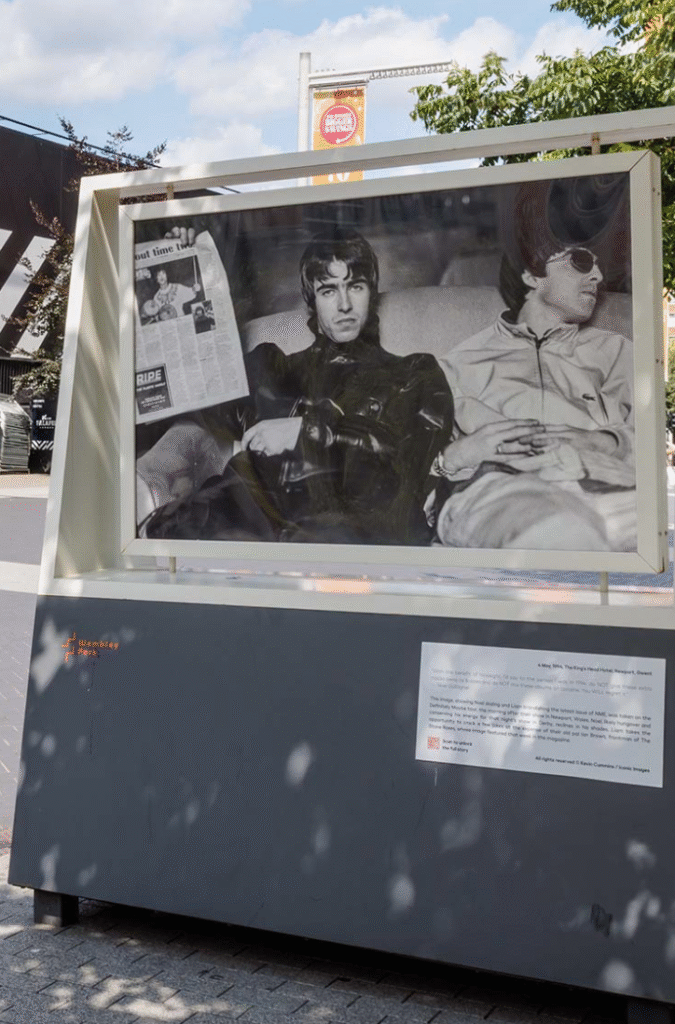
Kevin Cummins is known for his iconic portraiture of cult British bands and musicians including David Bowie, Joy Division, The Smiths and New Order, and was NME’s chief photographer during the 1980s into the 1990s. Creation Records approached Cummins in 1994 to photograph the Gallagher brothers, and the photo shoots he did with the youthful Liam and Noel went on to shape their public image.
Brothers is part of the Wembley Park Art Trail, which features large-scale works across the neighbourhood. Highlights include the now globally viral Swiftie Steps, a tribute to Taylor Swift; a mural dedicated to Lana Del Rey; and the Square of Fame, where visitors can see the handprints of artists including Madonna, George Michael, The Who, Bryan Adams, Kylie Minogue and Dolly Parton. The exhibition is free, fully accessible, and runs until 30 September 2025. The free, outdoor exhibition at Wembley Park is timed to coincide with the Oasis reunion gigs and runs until the end of September.
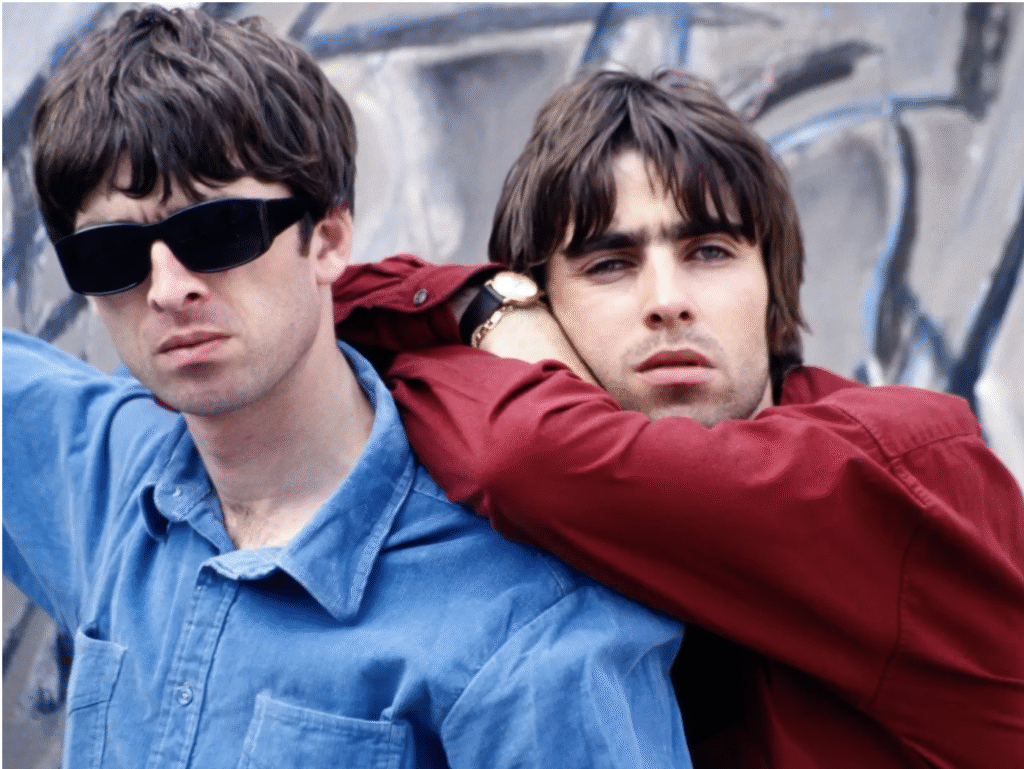
Culturalee: In what ways does the Wembley Park location, particularly its proximity to venues Oasis once headlined, enhance the emotional and cultural impact of the exhibition?
Claudio Giambrone: Oasis first played Wembley Stadium in July 2000, so this year marks exactly 25 years since that show. That felt like the right moment to do something that celebrates what they’ve meant to music and to their fans. They’ve also played both Wembley Arena and the Stadium a few more times over the years, so there’s a real connection with this place. The fact that the exhibition sits right between the two venues makes it even more meaningful.
What I really wanted to do was extend the experience beyond the gig itself. For the fans who were here 25 years ago, but also for younger ones who might not have been around in the 90s as well as the casual visitors, this gives a bit more context. It’s a way to understand the relationship between the brothers–not just the arguments or the public spats, but the bond, the humour, the moments of real affection that often get missed. Kevin Cummins’ photos really capture that, and his captions, along with a few quotes from Noel, add another layer to it all.
It also ties in with what we try to do more widely at Wembley Park. We don’t have a traditional art gallery or indoor exhibition space here, but we do have a public art trail with over 25 works across the neighbourhood, many of them linked to music and Wembley’s cultural legacy. So by placing this exhibition outdoors, along Olympic Way – or Wembley Way as fans call it – and between the Stadium and the Arena, it becomes part of the journey. The moment you get off the tube, you’re in it. It’s not about creating a separate art moment somewhere else. It’s about making it part of the whole experience.
How long was this exhibition in the planning stage for?
Since the moment the Oasis gigs were announced, I knew I wanted to do a tribute. Last summer, I curated a successful Taylor Swift photo exhibition with Getty Images using images from various photographers, so I already had the format in mind. Something visual, free and spread across the neighbourhood.
But Wembley Park isn’t an easy place to plan something like this. Everything has to fit around the stadium calendar, fan zones, sponsor activations and other estate-wide events. That means my photo boards can’t live in one fixed location, they’re constantly being moved and reconfigured to fit the space.
So while the idea was there for months, the physical planning couldn’t really start until much closer to the time. We had to wait until everything else was confirmed before locking in the layout. That’s just the nature of working in a live, ever changing public space like this, you need to stay flexible.
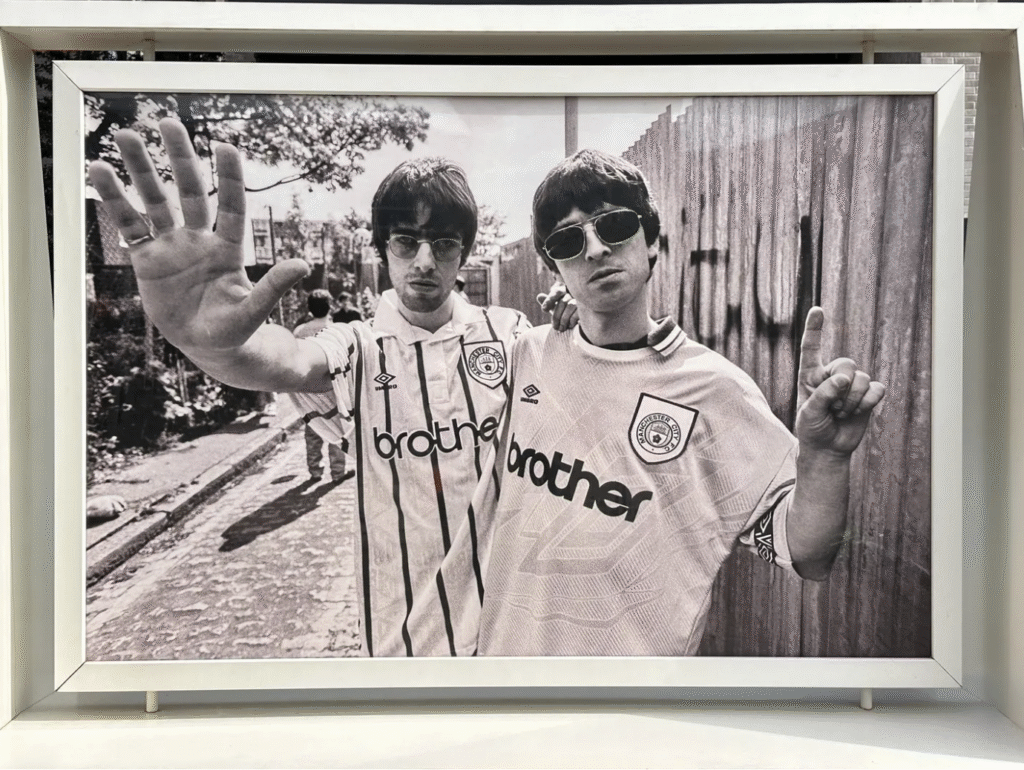
When did you first come across Kevin’s photography, and was it your idea to stage an exhibition to coincide with the Oasis reunion and Wembley concerts?
Claudio Giambrone: I knew Kevin’s name through some of his portraits of Nick Cave, who I’m a fan of, but I hadn’t really explored his Oasis work until I started working on this exhibition. I reached out to Iconic Images Gallery, who represent a number of photographers with material on the band. My original idea was to curate something about the whole, using images from different photographers. But they suggested I focus on just one, and recommended Kevin.
That’s when I found out he’d recently published a book of his Oasis work. They got in touch with him, and he kindly agreed to give me access to his archive of over 150 photographs. Once I saw the images, it was clear he was the right choice. There’s a level of trust in his work that goes beyond the usual press shots. His photographs feel honest and personal, probably because he’s also a personal friend of the brothers and worked with them on and off for 30 years.
As I went through them, I moved away from the initial idea for this to be a traditional band retrospective. What really stood out to me from Kevin’s material was the dynamic between the brothers. There’s affection, tenderness and a strong brotherly bond. I wanted the exhibition to focus on that. Something that would resonate not only with fans of the band, but with anyone who’s got a sibling.
Maybe that’s because I have a brother myself, so some of it felt close to home. There was definitely a personal connection. It struck a few chords. And choosing to work with a single photographer gave the show more cohesion. It allowed for a stronger narrative and a clearer emotional thread running through the whole show.
Culturalee: How do your 1994 images of Liam and Noel Gallagher featured in the “Brothers” exhibition challenge or reinforce the public perception of their famously turbulent relationship?
Kevin Cummins: It wasn’t turbulent when I took those photos. The point of them was to reinforce the sibling relationship. The fact that these photos have consistently been used over the past 31 years, proves that worked.
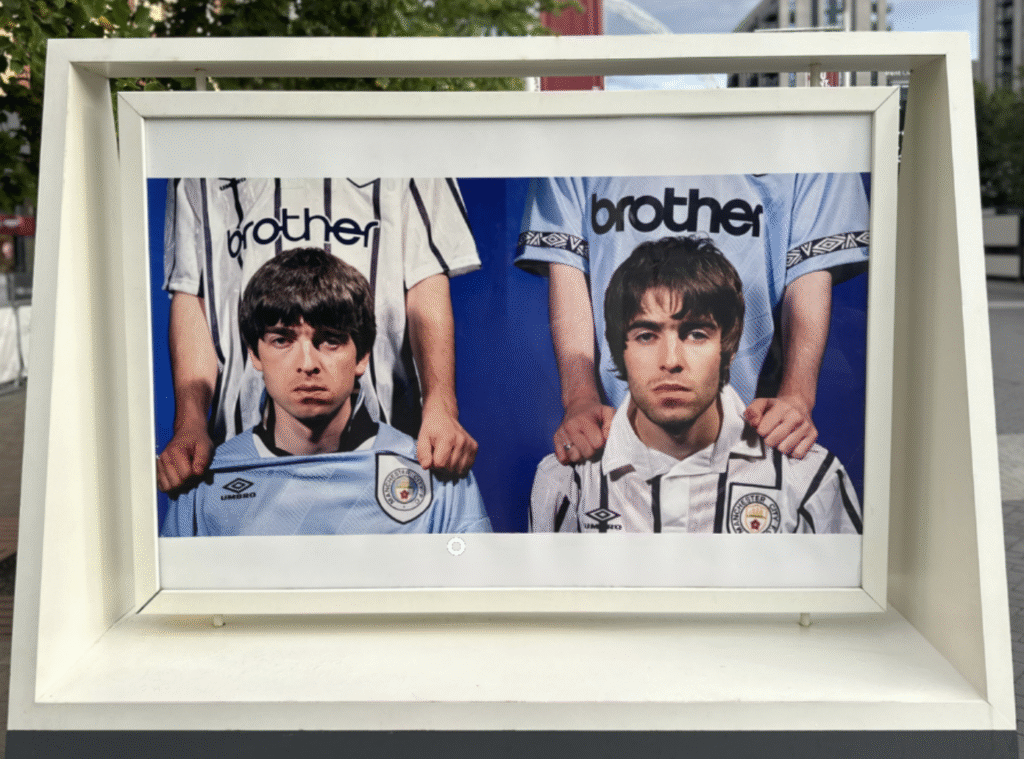
Brothers, Wembley, Oasis Photography Exhibition. Images by Kevin Cummins © KEVIN CUMMINS / ICONIC IMAGES
As a prominent NME photographer who captured some very natural images of the Gallagher brothers, what role (if any) do you feel you may have played in shaping Oasis’s early visual identity?
That’s for others to say really. The Brother shots helped take them to another level – especially in other territories – where some people were maybe unaware that Brother was a Japanese electronics company. In the USA I was asked more than once if it because they were a brotherhood. One journalist asked why I’d had Brother printed on the shirts, rather than Liam and Noel. They were also unaware of British sport at the time, so the Manchester City branding passed them by too.
What are your memories of the 1994 photo shoot, and how did you engage with the brothers to get such raw images?
There are many photo shoots from 1994. It wasn’t just one day you know. I was better known than they were at that time and they were aware of the work I’d done with some of their favourite musicians: Joy Division, The Smiths, Sex Pistols especially, so they were good to work with. They did everything I asked of them. We got on well because we liked similar music, supported Man City and had similar backgrounds.
This feels like a particularly significant time to showcase these archival photographs now that the Brothers have reunited on a tour after so many years. What do you feel is the significance of the images for longtime fans and a new generation discovering the band
They’re significant because they helped shape the way they were perceived by the public and the media. Many were taken to work out what best suited their image and helped form that too.


